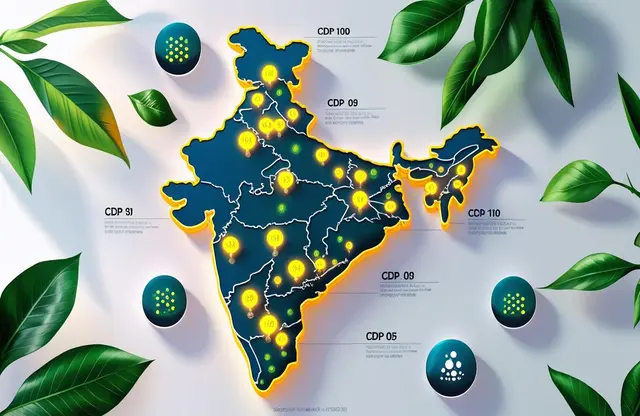An Informative Guide to the CDP Scoring Methodology – 2025
 Share
Share
 Copy Url
Copy Url

The CDP scoring methodology turns climate data into a simple report card, and no, it’s not as scary as it sounds. By translating environmental disclosures into a clear CDP score, the system helps companies spot gaps before investors do. One glance shows how well you face environmental risks and deal with financial risks linked to climate change. It also nudges better, greener choices by connecting every answer in the CDP questionnaire to real numbers, not guesses. Because each stakeholder loves transparency, the tool quickly signals which businesses curb carbon emissions and which still idle at the start line. Better scores open cheaper capital and keep supply-chain partners close.
In this guide, we first explain CDP scoring methodology and why it matters for growth. Next, we unpack the key factors that shape your score. Then we map the framework to ISSB, TCFD, GRI, and CSRD so your data flows smoothly across standards. We share best practices to lift your rating without breaking budgets. A short section explores data quality through an Indian lens, showing how local rules fit the global model. Finally, we outline how Report Yak can help you build ESG and sustainability reports that sparkle. Grab a notebook, set your goals, and let the learning begin—turn ratings into winning business strategies.

Understanding CDP Scoring Methodology and Why It Matters
The CDP scoring methodology keeps headlines buzzing with fresh CDP updates, yet its core aim is simple – turn raw climate data into a clear yardstick that anyone can follow. In the next few minutes, you’ll see why that clarity matters for every boardroom and back office.
CDP: The Global Climate Disclosure Hub
CDP is a non-profit platform that helps firms worldwide disclose environmental data for investors, customers, and cities. It turns sprawling surveys into one shared database that sparks action instead of confusion.
Four Straightforward Score Bands
- Disclosure – You share basic policies and numbers, such as Scope 1, 2, and 3 emissions, proving you can count what matters.
- Awareness – You show you grasp the risks and might act soon; think retailers like H&M climbing from D to C in one year.
- Management – You run projects with targets that cut costs and carbon; Tata Steel jumped here after rolling out smart-energy systems.
- Leadership – You influence peers and set the bar for climate leadership, as Infosys did after reaching net-zero campuses across India.
Why Scores Matter to Key Players
- Investors spot solid climate action and price capital accordingly.
- Supply-chain heads mitigate environmental issues by weeding out high-risk suppliers early.
- Regulators see transparent data and ease rule-making, boosting the benefits of sustainability reporting.
- Banks link strong scores to lower loan rates, rewarding sustainable business practices.
- Employees back firms that walk the talk, lifting morale and talent retention.
One Integrated Questionnaire: 2024 Shake-up
In 2024, CDP merged its separate climate, forests, and water security surveys into a single form. Companies now answer one streamlined set of questions on carbon, biodiversity, and resource use, cutting overlap and freeing teams to focus on improvements rather than paperwork.
Next up: we dive into the nuts and bolts that shape every CDP scoring methodology result, and how the 2025 scoring methodology fine-tunes those levers.

Key Factors That Shape Your CDP Score
The CDP scoring methodology tells the world how sustainable your company is. Disclose solid numbers and you receive a score that turns climate impact into plain language investors, clients, and regulators respect. Below are the levers that decide whether you ace the test.
Governance Steers the Sustainability Ship
Strong corporate governance keeps climate promises on track. Boards set clear roles, fund green projects, and release meeting notes that lift environmental transparency. This disciplined approach shows CDP that your firm steers sustainable progress with intent.
Risk Management Spots Trouble Early
Robust logs map how extreme weather could dent revenue. Teams rank environmental and climate impacts beside market shifts, feeding results into ESG reporting cycles. CDP sees a company ready for shocks, not reacting in panic.
Targets Turn Ambition into Numbers
CDP wants near-and long-term goals. You set science-based cuts for direct and indirect emissions, add gains on biodiversity, and time-stamp each milestone. Clear targets let reviewers trace progress, dollar by dollar, tonne by tonne.
Metrics Track the Daily Grind
You log energy, waste, and water in dashboards that feed annual sustainability reports. If metrics also capture savings from a circular business model, CDP applauds a leap toward the circular economy rather than linear take-make-waste habits.
Verification Keeps Everyone Honest
Independent auditors sample data trails, confirm baselines, and publish assurance letters. This outside check slams the door on greenwashing and boosts trust. CDP treats verified figures as gold, often nudging scores up a full band.
How CDP Weighs Each Piece
At Management and Leadership levels, categories carry set weights - governance ~10 %, targets up to 25 %, metrics c. 20 %. CDP’s new “essential criteria” rule means you must hit every must-have question or stall in the band, even if other marks soar. These changes to the scoring push firms to show real progress towards environmental stewardship rather than cherry-picked wins.
Evidence CDP Reviewers Expect
- Policies – Climate, water, and waste policies, plus sustainability reports that spell out board sign-off and yearly reviews.
- Detailed Data Tables – Raw figures that feed both ESG reports and internal dashboards, split by site and quarter for easy checks.
- Board Oversight Notes – Minutes that prove directors quiz teams and promote environmental transparency during risk talks.
- Independent Assurance Statement – External auditors verify data, including novel product-as-a-service (PAAS) savings, and sign an ISO-aligned letter.
- Science-Based Target Validation – Letters from SBTi showing goals match 1.5 °C, flagging pathways for ESG reporting alignment.
- Supplier Engagement Metrics – Scores, audits, and contracts that track upstream footprints and drive lower freight miles.
Next, we link this CDP scoring methodology framework to ISSB, TCFD, GRI, and CSRD so your disclosures line up everywhere.

Linking CDP with ISSB, TCFD, GRI, and CSRD
Reporting frameworks are finally singing from the same song sheet. The CDP scoring methodology now lines up with ISSB, TCFD, GRI, and the EU’s CSRD, boosting transparency for investors and other stakeholders while trimming hours lost to form-filling.
Mapping to IFRS S2 Climate-related Disclosures
CDP’s 2024 questionnaire mirrors ISSB’s IFRS S2 line by line. Companies now disclose governance, strategy, risk, and metrics on greenhouse gas emissions in a format investors already know. The shift simplifies board sign-off, cuts data drift, and lets the CDP scoring methodology stay synced with annual filings. It makes it easier for teams to avoid recalculating the same numbers in different spreadsheets.
TCFD Pillar Overlaps
TCFD rests on four pillars: governance, strategy, risk management, and metrics. CDP questions tuck neatly under each, so firms answer once and please both sets. The overlap means a single update on environmental impact and climate issues for TCFD doubles as evidence in CDP.
GRI Standards Synergy
GRI topic standards already track emissions, energy, and biodiversity. CDP has mapped its climate, water, and forest questions to these disclosures, letting preparers lift data straight from existing sustainability reports. One dataset now feeds both frameworks and keeps corporate targets consistent.
CSRD Interoperability
Europe’s CSRD demands detailed environmental data under ESRS. CDP and EFRAG issued correspondence tables in 2025 showing how questions match ESRS E1 fields and scoring criteria. Companies can reuse CDP figures to meet EU rules, slashing translation work and audit costs.
Benefits of a Single Playbook
1. Fewer Duplicate Questions
Answer once, submit everywhere. Framework alignment frees sustainability teams to analyse numbers instead of copying them, saving real money and energy.
2. Smoother Regulatory Compliance
Legal teams pull CDP tables straight into statutory filings. Auditors recognise headings, so sign-off comes faster and cheaper.
3. Sharper Board Decisions
Consolidated data packs put risk, opportunity, and climate change mitigation costs side by side. This drives quicker funding calls and clear accountability.
4. Stronger Investor Confidence
Comparable numbers cut perceived risk, unlock cheaper capital, and reward firms that show credible progress.
5. Easier Internal Benchmarking
Teams track a company’s score against peers, sparking healthy competition to beat, not just meet, targets.
6. Faster Supply-Chain Roll-outs
Suppliers recycle CDP data into procurement portals, extending good practice deep into Tier-2 factories without drowning them in paperwork.
7. Better Public Storytelling
One dataset powers press releases, ESG reports, and sales decks, ensuring messages align and withstand media scrutiny.
8. Unified Audit Trail
Assurance providers test figures once, apply results across frameworks, lower fees, and free management bandwidth for innovation.
9. Early Warning Signals
A single database lets analytics flag deviations fast, helping teams prevent reputational hits and fines before they arise.
Now that the frameworks are in place, let’s explore the best practices that can raise any CDP score from average to outstanding.

Best Practices to Lift Your CDP Score
A few smart moves can shift your CDP scoring methodology needle faster than a caffeine shot. Use the checklist below to swap guesswork for data points investors trust, then watch those score levels climb. Remember, CDP is a platform for companies to disclose climate data through the CDP—so every line you polish counts.
Quick-win Checklist
- Third-Party Verification
Auditors test figures and certify the completeness of their reporting, matching CDP scoring criteria and silencing greenwashing doubts.
- Science-based Targets
Set Paris-aligned goals covering direct and indirect emissions; spell out the transition plan clearly. CDP flags such targets as targeted improvements and rewards them.
- Scenario Analysis
Assess how 1.5 °C or 2 °C futures hit cash flow. The exercise proves you can assess risk before it bites and back up disclosures with numbers investors respect.
Long-term Moves Checklist
- Board Climate Training
Directors learn to grill strategy with fresh climate questions, turning oversight from box-ticking to real assessment that shapes corporate governance.
- Supplier Engagement
Map Scope 3 emissions hot spots and coach partners to cut footprints. CDP loves proof that influence reaches beyond your gates.
- Renewable-Energy PPAs
Lock in clean power deals, hedge price shocks, and trim emissions year after year. Such contracts show steady progress towards environmental stewardship.
Mini-case: PepsiCo’s Rapid Climb
PepsiCo answered CDP’s call with science-based targets, supplier scorecards, and third-party audits. It funnelled fresh climate data through the CDP, closed disclosure gaps, and tied executive pay to climate goals. Within two cycles, its grade jumped from C to A, proving bold moves beat baby steps.
Tick these boxes and your CDP scoring methodology journey is half won—next, we’ll see why tight data quality and an Indian business lens can lock those gains in.

Data Quality and the Indian Business Lens
Indian firms face a double audit: one from the CDP scoring methodology and another from SEBI’s new BRSR Core. Scoring hinges on the level of detail and comprehensiveness you share, so let’s see what counts and how to keep both scorekeepers happy. Especially when measuring India's growth on the Sustainable Development Index.
CDP’s Data-Quality Gates
Completeness
Provide every requested field; CDP reviewers match responses against disclosure scoring rules and flag gaps fast. They trust data through the CDP rating only when nothing is missing.
Consistency
Numbers must repeat the same units and periods each year. That proves management methods and progress towards improvement, not guesswork.
Third-Party Assurance
External auditors verify totals, adding weight to climate targets and turning spreadsheets into evidence.
Audit trails
Secure logs track edits, proving each fact back to source. This rigour supports a good CDP score and keeps regulators calm.
Indian Compliance Links
SEBI BRSR Core Metrics
Top-listed companies must disclose 49 climate and social indicators and obtain limited assurance by FY 2025-26.
Assurance Timeline
External auditors sign off in two phases: 2024-25 for core metrics, 2025-26 for value-chain data. The CDP questionnaire helps companies prepare early by aligning formats.
Regulator’s View
“The disclosures have to be honest disclosures, and there has to be a capacity to measure accurately. Because if they turn out to be only paper disclosures or false disclosures, then it is going to create another set of problems.” - Tuhin Kanta Pandey, SEBI Chairperson
Sector Snapshots
IT – Infosys and Wipro report granular energy stats and science-aligned goals, earning investor trust and high marks in 2024.
BFSI – Banks like HDFC and YES Bank lag on financed emissions transparency but have begun scenario analysis to catch up.
Manufacturing – Tata Steel links supplier data to its climate platform, showing consistency from ore to coil and boosting export credentials.
With these checks in place, the CDP scoring methodology rewards substance over spin. Next, we wrap up with your action list and our support offer.

Report Yak Guides Your CDP Scoring Methodology Journey
Mastering the CDP scoring methodology is no longer a box-ticking chore—it is a fast track to trust. Investors, regulators, and other stakeholders now demand clear signals that a company is serious about reporting on climate. Report Yak meets this need. As a sustainability report design agency, we weave hard data into engaging narratives that meet every assessment criterion without jargon.
Our team turns raw figures into polished sustainability reports and ESG reports that resonate in boardrooms and on shop floors. We pair rigorous annual report design with eye-catching infographics, making complex metrics easy to grasp. Need sharper targets, sturdier audit trails, or richer context? We align each page with the latest scoring guidance so your company shines in every disclosure.
Ready for a score that reflects the real work you do? Book a discovery call today for tailored CDP-readiness audits, mini-gap analyses, and full disclosure support. Explore our Work, dial 1800 121 5955 (India), email contact@reportyak.com, message us on WhatsApp, or leave your details via our Contact form. Let’s turn disclosure into decisive climate action.
Related Posts
-
How To Adopt BRSR Guidelines For Success
Oct 15, 2025Share
Copy Url
Simplifying ESG Disclosure for Better Impact
corporate reportingenvironmental and social initiatives
+6
Aug 28, 2025Share
Copy Url
GRI Sustainability Taxonomy: Learn How to Turn Data Into Advantage
corporate governancecorporate reporting
+11
Jul 1, 2025Share
Copy Url


